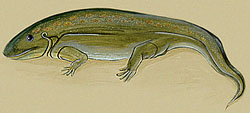|


magine traveling back through time millions of years to the age of the
dinosaurs. Pterodactyls glide above a soggy marsh. Nearby, a colossal
80-ton Brachiosaurus munches on a tree. On the ground at its feet, something
strangely familiar hops by: a frog.

|

|
|
|
Ichthyostega,
prehistoric predecessor to the modern frog, lived 370 million years
ago during the Devonian Period. Sometimes referred to as "the
first four-legged fish," skeletal remains of this earliest-known
amphibian were first discovered in East Greenland. [
Click
for a larger image.] Illustration by Khristine A. Page.
|
Surprised? Few people realize
just how ancient frogs are. For 190 million years, the ancestors of
modern frogs have roamed (if not ruled) the earth, looking much the
same as they do today. The secret to their success is their amazing
adaptability.
As amphibians, frogs have one webbed foot in each of two worlds. The
advantages of this double life are clear to see: Are land predators
giving you trouble? Dive into the water. Not enough to eat in the pond?
Hop out and see what they're serving on shore.
Frogs have evolved to live in
an astounding variety of climates. They can be found just about anywhere
there's fresh water, from the desert to the Arctic, on all continents except
Antarctica. Though they thrive in warm, moist tropical climates, frogs also
live in deserts and high on 15,000 foot mountain slopes. The Australian
water-holding frog is a desert dweller that can wait up to seven years for
rain. It burrows underground and surrounds itself in a transparent cocoon
made of its own shed skin.
Like all amphibians, frogs are
cold-blooded, meaning that their body temperatures change with the temperature
of their surroundings. When temperatures drop, some frogs dig burrows
underground or in the mud at the bottom of ponds. They hibernate in these
burrows until spring, perfectly still and scarcely breathing. Wood frogs
can live north of the Arctic Circle, surviving for weeks in a frozen limbo
state. This frog uses glucose in its blood as a kind of antifreeze that
concentrates in its vital organs, protecting them from damage while the
rest of the body freezes solid.

Frogs have a reputation for leaping that is well deserved. Launched
by their long legs, many frogs can leap up to twenty times their body
length. (That would be about a 100-foot jump for you or me!) The longest
frog jump on record was made by a frog named Santjie at a frog derby
held in South Africa. Santjie bested the competition with a jump of
33 feet 5.5 inches.
© 1999,
The
Exploratorium
|


